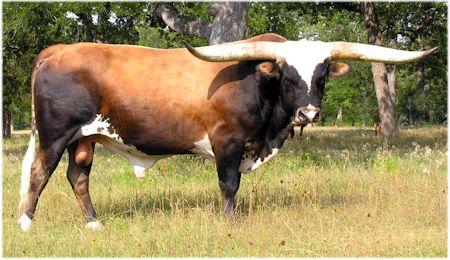Beef, Beauty & Bloodline: What to Look for in a Top Longhorn Sire

When you are thinking about developing a fruitful Texas Longhorn herd, selecting the right sire can make or break your breeding program. An ideal Longhorn bull should not only be aesthetically pleasing, with unique horn structure, but rather an overall value—an entire package. Whether you're a breeder trying to enhance the herd's genetics or a rancher wanting to grow their herd, you will want to think about traits relating to beef production, conformation, horn growth, and pedigree before choosing the appropriate sire. The right sire can enhance not only your calves' physical features, but also their price, fertility, and productivity down the road.
It is essential to remember whether you are starting a new breeding program or if you are a seasoned rancher, to understand what makes up an above-average Longhorn sire. Let's take a look at the seven most important characteristics that should affect your decision.
Muscular Build and Beef Quality
One of the main reasons Longhorn cattle are being raised is to achieve high-quality beef. A good Longhorn sire should have balanced muscling, especially in the shoulders, loin, and back-end. The sire should not be excessively bulky as in commercial beef breeds, but should have enough muscle definition to pass on desirable carcass traits. Look for bulls that have straight toplines, adequate depth of body, and a suitable length. These features to produce meat efficiently can lead to more profit when it comes time to market feeder or finished calves. In today's niche markets, a bull must produce calves that will yield lean, tender beef, especially as it pertains to grass-fed and natural beef programs.
The ideal sire should produce calves that finish their weight on forage with little input. Always review progeny performance data (if available) to evaluate meat yield and consistency; and in summary, muscle tone and beef efficiency should never be sacrificed based on appearance alone.
Horn Length, Shape, and Growth Potential
In the longhorn world, horns are a universally recognized component. Horns are not just purely aesthetic; they symbolize lineage and marketability. A quality sire should show great potential for growing horns. Specifically, getting horns to develop laterally and grow symmetrically is vital. While the total length of the horn is a main focus of marketing, the shape and direction of the horns are just as significant. Variations in shape include flat with pronounced outward-curve horns, which are preferred for show and breeding purposes because breeders view these horns as having been made with careful genetics, and usually have more market value.
The annual measurement of a bull's horns can quantify horn growth rate, which is indicative of what growth would be expected in offspring. It may also be prudent to observe the horn growth in the bull's offspring, especially the heifers, since females are usually valued more in the horn contest.
Fertility and Reproductive Health
Fertility is a key characteristic in a Longhorn sire; a bull with great genetics and looks is simply worthless if he can't breed. Check for semen motility, scrotal circumference, and reproductive soundness before putting him to work. A breeding soundness exam (BSE), one of the Gold standards, should be done before the bull's first breeding season, and periodically thereafter. Bulls with healthy, larger testicles typically produce the most sperm. Healthy bulls often experience sexual maturity sooner than smaller bulls, and healthy bull attributes are passed to male calves as well.
Besides, you should also check the bull's libido and ability to get the cows bred by looking to see that they cover. Look for lameness or issues in joints, such as limits to his performance on pasture. A bull with a high fertility rate guarantees that you get the most calves on the ground in the least amount of time.
Proven Pedigree and Genetics
Before you purchase, you will want to study both the maternal and paternal lines for horn growth, fertility traits, disposition traits, and beef quality expectations, if applicable. Elite sires are often descended from generations of sires or cows that had multiple descendants that were exceptional in terms of production or showed multi-year performance as a sire or dam. Vendors of reputable Longhorn cattle will provide all registration papers and testing for genetic testing confirmation of lineage and purity. Do not purchase bulls without pedigree or questions about their heritage--- it can only lead to complications with registration and reduced quality herd genetics. If you are raising specific traits, you will want to make sure the genetics of your bull represent those genetic markers.
If you are still not certain what traits to choose in a bull, always choose bulls from reputable breeding programs that have generated trust in their breeding program and generally produce cattle that are successful for you.
Disposition and Temperament
Longhorns have a reputation for being intelligent and calm, and your sire should share those characteristics. A bull with an aggressive or unpredictable disposition can be dangerous to handlers and cows alike. And worse, bad behavior is often heritable. Bulls with good manners and calm behavior in the chute or pasture will be easier to manage for handlers and less prone to injuring themselves or other animals. Invest some time watching the bull's behavior with people, other bulls, and cows. Is the bull skittish, pushy, territorial, or relaxed and confident? Temperament also impacts breeding performance; a calm bull should be more efficient in breeding and will not put as much stress on the herd.
Bulls with a gentle nature leave a lasting mark on the herd and offer a more manageable and safer experience, especially if you are involved in youth programs, agritourism, or show cattle. There will always be a place for bulls that allow both power and peace of mind.
Structural Soundness and Longevity
Structural soundness is essential for a sire's longevity and fertility. A thorough examination of a bull's feet, legs, and joints is vital to determine that he does not have any conformational defects that will worsen with time. The ideal Longhorn sire will have straight legs, solid pasterns, a wide chest, and a good, solid topline. Additionally, bulls with hoof problems, cow hocks, and/or arthritis should be avoided because these issues may cause the bull to retire earlier rather than later. The longer your bull can successfully breed and remain productive, the more dividends you will reap on your investment.
The End
When choosing a top Longhorn herd sire, you are not only selecting the bull with the longest horns or prettiest colors but also selecting the right balance of beef quality, genetic strength, aesthetics, and temperament. Whether your Longhorns are being raised for show, for meat, or for breeding stock sales, every trait counts-fertility, soundness, pedigree, and patterns that appeal to the market are all important.






